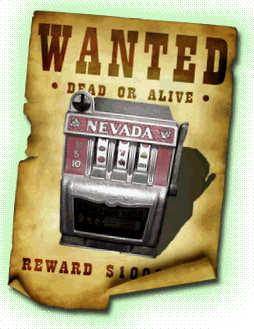 The Rise and Fall of the One-Armed Bandits
The Rise and Fall of the One-Armed Bandits
A history of mechanical slot machines
The One-Armed Bandit is the nickname given to the old-style slot machines with a lever on the side.
For over 70 years these slots roamed the planet, relieving unwary victims of their money!
This is the story of how they started, how they beat the lawman, and how they eventually died out.

|
|
|
The First Ever Pokie Slot Machine
Back in 1891 when poker had become fashionable in America, two enterprising New Yorkers Sittman and Pitt devised a poker machine for a solo player. These early
pokie machines were very different to the more exciting
online casino games that we see today! The Sittman and Pitt machines featured a glass panel behind which were five reels, each having 10 playing cards mounted on it. There were no side levers on these machines so instead, when you'd put in a coin, you pressed a plunger down. This spun the reels and the cards flipped over.
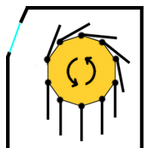 The mechanism was delightfully simple but the machine itself didn't pay out (in most states a cash prize would not have been allowed). However the machines were almost always located in bars, so if you got a winning poker hand, the bartender would pass over a prize. These days many people find it more convenient to play online slot games.
The mechanism was delightfully simple but the machine itself didn't pay out (in most states a cash prize would not have been allowed). However the machines were almost always located in bars, so if you got a winning poker hand, the bartender would pass over a prize. These days many people find it more convenient to play online slot games.
On the pictured machine, the best hand (a royal flush) would win you 100 cigars! The smallest prize was a single cigar, awarded for a pair of kings or aces.
Of course, five reels with ten cards only used 50 cards in the deck. To reduce the chances of a royal flush, the two unused cards were generally high value, often a ten and a jack of different suits. This would mean that out of the four royal flushes, only two were possible. On a fair machine, the chances of getting one of these two royal flushes would have been 1 in 50,000.
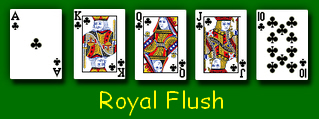
The percentage of wins that any machine allowed could further be controlled by changing the cards around on the reels. An unscrupulous bar owner might have arranged for all four aces to be on the same reel, so eliminating the chance of two, three or four aces coming up. However this would have been extremely foolish as the customers would be sure to notice!
|
|
|
The Automatic Payout - and the birth of the bandit!
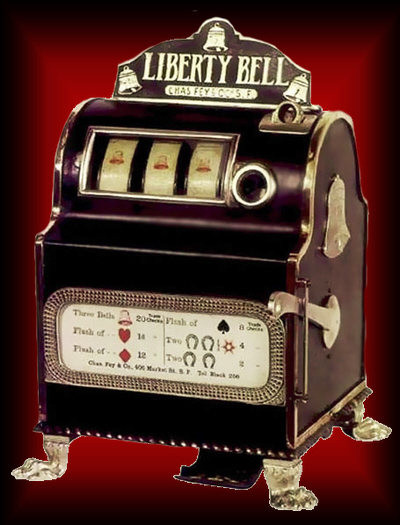
The Percentage Regulator
Fey also devised a cunning extra feature for the machine operators.
By adjusting how the reels stopped, the average payout of the machine, also referred to as RTP, could be lowered from 75% right down to 50%!
|
|
Although the poker machine was as fun as playing at
safespin.com,
it needed a human to recognise all the possible winning hands and award the prizes. However by 1895, a San Franciscan motor engineer called Charles Fey had developed the Liberty Bell. It was the first slot machine that paid out automatically, and the original machine can still be seen in Nevada.
Fey had simplified the game down to just three reels, and it only featured five different symbols: Hearts, Diamonds, Spades, Horseshoes and the "Liberty Bell".
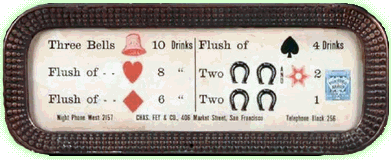
The Liberty Bell was a massive success, not only because of the possible prizes, but also because of the lovely chunky feeling that pulling the lever on the side gave. As the lever came down, it went through a routine of tasks. It primed a strong clockwork mechanism that fired the reels round, then after braking them, it dropped a set of probes across the reels to establish how they had finished. Finally, if the probes detected one of the winning combinations, the machine would spit some coins down to rattle in the tray. The whole joyous operation took less than few a seconds, and having another go was irresistible.
Fey had two more ingenious ideas which added to the fun. The first was that the reels would brake in turn, rather than all together which added to the suspense. The second was that a bell would ring when a prize was won. This gave the player an extra little thrill, but it also announced to people nearby that the machine was paying out!
Thanks to the side lever and their ability to collect money, these machines became known as the one-armed bandits.
|
|
|
|
|
The Odds
The original Liberty Bells had ten symbols on each reel. If the bell symbol itself only appeared once on each reel, then the chances of getting the three bells were 1/10 x 1/10 x 1/10 = 1 chance in a 1000.
Later machines had four or even five reels with up to 20 symbols on each reel, and the number of different symbols increased. This meant that much bigger jackpots could be offered, but the chances of winning them were greatly reduced. It also made it much harder for players to work out the odds of winning, especially as (secretly) the reels never stopped on some of the symbols!
At best, the original machines paid out about 75% of what they took. Therefore over a long series of games, for every $1 you put in, you would hope for 75c back. Happily most modern slots
and online games pay out over 90%!
|
|
|
Beating the Gambling Bans
By 1902 many states had decided to ban these poker-type gambling machines, so the machines quickly evolved to get round these bans in a variety of ways.
To avoid looking like poker machines, the card symbols were abandoned and instead a range of other images were adopted. The most enduring set of symbols were the fruits which is why in many countries including the UK, slot machines are commonly known as fruit machines.

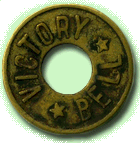 When states decided to ban cash payouts, although the machines accepted nickels (5c coins), for prizes they issued trade checks instead. These were usually in the form of metal tokens similar to coins, but with a hole in the centre. These trade checks could either be inserted to pay for further games, or exchanged at a counter for cash or prizes.
When states decided to ban cash payouts, although the machines accepted nickels (5c coins), for prizes they issued trade checks instead. These were usually in the form of metal tokens similar to coins, but with a hole in the centre. These trade checks could either be inserted to pay for further games, or exchanged at a counter for cash or prizes.
Another ruse was to have a gum dispenser attached to the machine, so when you put in your 5c, you "bought" a very overpriced stick of gum. You also got a "free" game - and as you hadn't paid a stake, this was not recognised as gambling!
| |
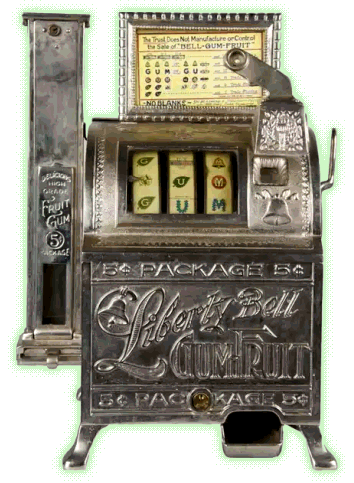
|
|
There were even machines with future payouts.
These machines had an extra panel that could display a number or the word "no".
You put in your 5c and if you got a winning line, the machine would simply show a number e.g. 6. You hadn't won any money, so this was not gambling. However this number told you how many coins you would get if you put another 5c into the machine.
Because you knew that your next 5c would give you 30c, this was not gambling either!
| |
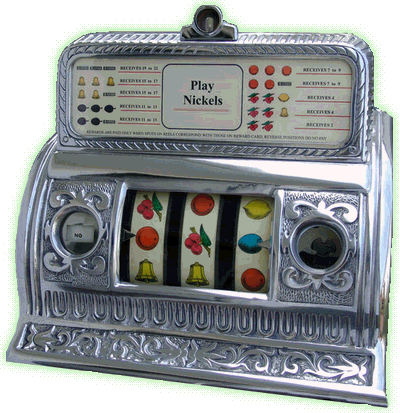
|
|
|
|
Further Developments - and the death of the bandit
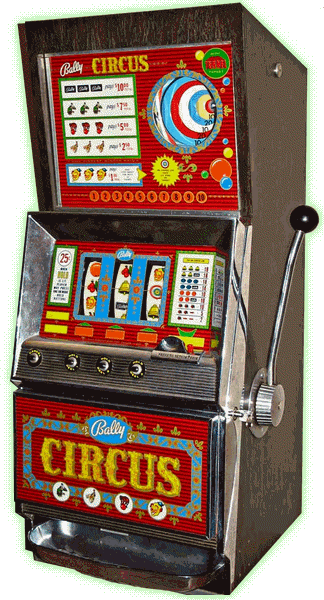
The automatic cash payout meant that machines could operate without any human help. This allowed arcades to flourish where rows of machines could be lined up together offering fun, noise and hopefully prizes! For many years, Nevada was the only US state which allowed these machines, and so this is where the greatest and grandest arcades flourished.
With the advent of electro-mechanical machines, extra features could be added to give more opportunities for skill and so increase the fun.
 The nudge button allowed a player to shift any reel down one position to enable a win.
The nudge button allowed a player to shift any reel down one position to enable a win. The early nudge machines used to buzz very loudly, giving the player just a couple of seconds to decide what to do. If a player reacted quickly there might be time for three or four nudges, and making the most of these not only required a great deal of skill, but also a knowledge of the particular machine. Later machines gave a set number of nudges, thus allowing the player more time to plan a strategy.
The hold button allowed a player to stop one or more reels spinning, so that the more valuable symbols might be kept on line, or two matching symbols could be held hoping the third might arise.
 At first, many of these electro-mechanical machines retained the side lever, but when the clockwork became redundant, pulling the lever only closed an electrical contact. Sadly the mechanical feel was gone, and soon the lever was abandoned in favour of the much cheaper "play" switch.
At first, many of these electro-mechanical machines retained the side lever, but when the clockwork became redundant, pulling the lever only closed an electrical contact. Sadly the mechanical feel was gone, and soon the lever was abandoned in favour of the much cheaper "play" switch.
The one-armed bandit was dead!
|
|
|
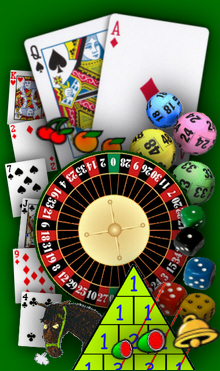 There are more stats and facts about games here:
There are more stats and facts about games here:
Craps - How to play, Chances and Payouts
Blackjack - Hit, Stand, Double Down or Split?
Chances of Card Hands
Crown and Anchor Dice Game
The Betting Guide - and how to work out the Bookie's profit!
Accumulator Bets
The Roulette Wheel ... and how to worry the casino!
The One-Armed Bandit Slot Machine
How many ways can you put a pack of cards in order?
The National Lottery Odds
Kjartan's Games Home Page
Contact/Enquiries
|

 The Rise and Fall of the One-Armed Bandits
The Rise and Fall of the One-Armed Bandits

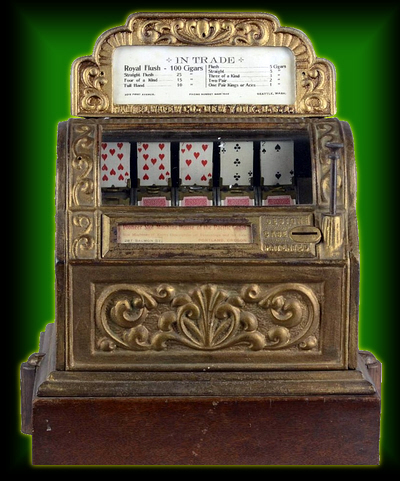
 The mechanism was delightfully simple but the machine itself didn't pay out (in most states a cash prize would not have been allowed). However the machines were almost always located in bars, so if you got a winning poker hand, the bartender would pass over a prize. These days many people find it more convenient to play online slot games.
The mechanism was delightfully simple but the machine itself didn't pay out (in most states a cash prize would not have been allowed). However the machines were almost always located in bars, so if you got a winning poker hand, the bartender would pass over a prize. These days many people find it more convenient to play online slot games.




 When states decided to ban cash payouts, although the machines accepted nickels (5c coins), for prizes they issued trade checks instead. These were usually in the form of metal tokens similar to coins, but with a hole in the centre. These trade checks could either be inserted to pay for further games, or exchanged at a counter for cash or prizes.
When states decided to ban cash payouts, although the machines accepted nickels (5c coins), for prizes they issued trade checks instead. These were usually in the form of metal tokens similar to coins, but with a hole in the centre. These trade checks could either be inserted to pay for further games, or exchanged at a counter for cash or prizes.


 The nudge button allowed a player to shift any reel down one position to enable a win.
The nudge button allowed a player to shift any reel down one position to enable a win.  At first, many of these electro-mechanical machines retained the side lever, but when the clockwork became redundant, pulling the lever only closed an electrical contact. Sadly the mechanical feel was gone, and soon the lever was abandoned in favour of the much cheaper "play" switch.
At first, many of these electro-mechanical machines retained the side lever, but when the clockwork became redundant, pulling the lever only closed an electrical contact. Sadly the mechanical feel was gone, and soon the lever was abandoned in favour of the much cheaper "play" switch.
